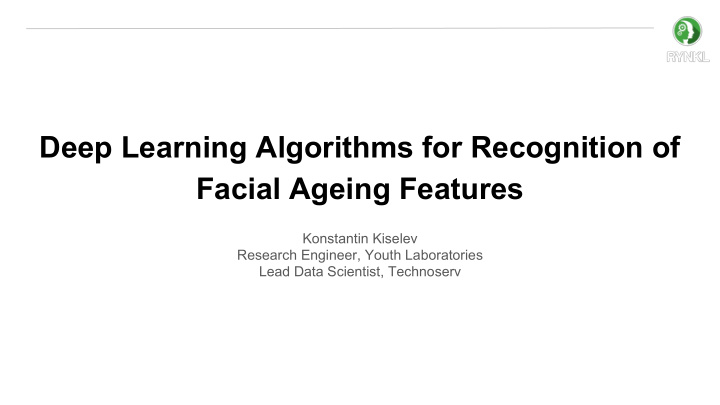



Deep Learning Algorithms for Recognition of Facial Ageing Features Konstantin Kiselev Research Engineer, Youth Laboratories Lead Data Scientist, Technoserv
About us Youth laboratories - the team of IT, biogerontology and machine learning experts, who are dedicated to developing effective interventions to keep people young, healthy and beautiful. Kickstarter campaign Projects Others: Ageing and disease features recognition
Agenda 1. Motivation and concept 2. Applied technologies and algorithms 3. Performance: GPU remarks 4. How to collect the datasets 5. Vision and plans
How do you evaluate your skin condition? Partial opinion Cosmetologist Biased Dermatologist Variable or other doctors Time + Money Self (mirror) Biased Partial opinion Other people Biased Variable
Tasks 1. A tool for measuring the changes of skin condition and appearance in general
Tasks 1. A tool for measuring the changes of skin condition and appearance in general 2. Mobility and availability
Tasks 1. A tool for measuring the changes of skin condition and appearance in general 2. Mobility and availability 3. To track the effect of treatments and the reliable response on their efficiency 4. Recommend the most appropriate cosmetology or skin treatment type
Motivation: facial aging and diseases features Under-eye Wrinkles Wrinkles circles Nevuses Dark Birthmarks spots Skin Moles cancer
Motivation: facial aging and diseases features It’s important to be able to detect them at early stages when the probability to cure it without any consequences is high
Motivation: facial wrinkles Your facial wrinkles are one of the key indicators people use to guess your age How to distinguish and track the effect of various skin treatments? Go further to recognize another biomarkers
RYNKL app - application for tracking facial wrinkles Android, iOS - beta version available Now traditional approach is deployed Deep learning approach is being researched Cloud based system
Approaches and implementations Implementations (Theano, OpenCV, Lasagne/Keras/Caffe): - CPU - GPU Approaches: - Traditional computer vision and machine learning - Deep convolutional neural networks
General process
Traditional computer vision and machine learning Face detection - retrained OpenCV cascade Facial zone - ensemble of regression trees, retrained for 50 fiducial points (dlib implementation) + contours detection Alignment - affine transformation Wrinkles area detection - cut areas by support points Wrinkles map - brightness normalization, several stages of Gabor filters, morphological transformation, adaptive thresholding. Calculate RYNKL score
Traditional approach: problems 1. Facial areas detection - insufficient accuracy of detection of facial boundary points; 2. Impossible to select perfect parameters of the image processing for all cases of lightning and shadows; 3. Flecks of light erase information about facial wrinkles - impossible to recover!
Deep learning approach 1. VGG-11 for facial areas detection 2. Two architectures for wrinkles score calculation: a. VGG-16 - predict RYNKL score b. SegNet* - build wrinkles map * Alex Kendall, Vijay Badrinarayanan and Roberto Cipolla "Bayesian SegNet: Model Uncertainty in Deep Convolutional Encoder-Decoder Architectures for Scene Understanding." arXiv preprint arXiv:1511.02680, 2015.
Facial area segmentation VGG-11: - training set - HELEN, MUCT and others - CNN architecture: FC-4096 conv3-256 conv3-512 conv3-512 conv3-64 conv3-128 FC-4096 224x224x3 conv3-256 conv3-512 conv3-512 60 points image maxpool maxpool FC-1024 maxpool maxpool maxpool Soft-Max
Building wrinkles map Use SegNet with 112x112x3 -> (rescale) -> 224x224x3 input Encoder - VGG-16 without fully connected layers Decoder - upsample the input SegNet schema was taken from article “A Deep Convolutional Encoder-Decoder Architecture for Image Segmentation”
Gliding window Each area size is normalized to fixed width - unique for each area. I.e. forehead’s width is 560 px. 56 112x112 Convolutional neural network 112x112 56 124x124 Wrinkle 560 124x124 map 124x124 112x112 of window
Train and test Manually marked - 100 images, 100 individuals - 200 images, 20 individuals Test (images-individuals): - MSE (60-36): traditional - 0.39, deep learning - 0.32
Implementation - Theano + Lasagne/Keras/Caffe for neural network implementation - OpenCV for image processing - GPU for train and test - Nvidia Tesla K80
Performance Performance on Tesla K80 - facial areas points detection: - prediction - 0.02 s; - building wrinkles map: - prediction - 0.04 s; Compared with CPU (i7 Xeon) training on GPU (Tesla K80) is faster ~20 times!
How to collect the dataset First international beauty contest judged by AI (1 Dec 2015 - 18 Jan 2016): ~3000 images ( >2K resolution) + bio parameters (weight, height, age, gender, ethnicity, country) The second contest is going to start on ~ 1 May 2016 It will include skin type in parameters
Plans and perspectives Technology improvement: - complete and deploy deep learning approach - move some computation to device size Directions of grows: - another ageing biomarkers recognition - skin diseases detection - recommendation of skin treatments based on skin type and other bio parameters Core idea - allow people to make self-test of their skin condition. Application gives just recommendations - doesn’t diagnose.
Thank you for your attention! Questions? Konstantin Kiselev Research Engineer, Youth Laboratories Lead Data Scientist, Technoserv mr.konstk@gmail.com
Recommend
More recommend